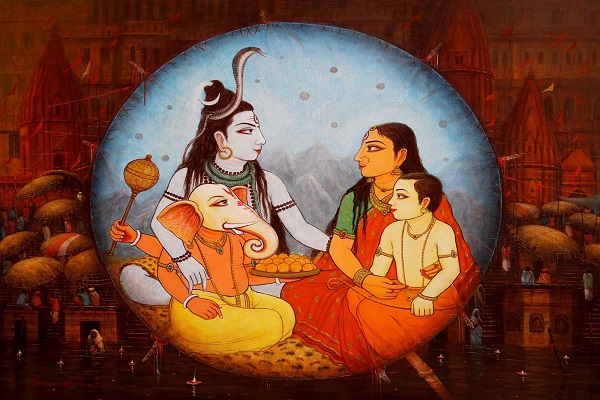
"Art enables us to find ourselves and lose ourselves at the same time." - Thomas Merton
There is an intense yearning for connection to our roots, to the traditions that have shaped our civilizations for millennia, amid a world of rapid modernism and technological advancements. Traditional paintings connect our current lives to our rich history with their eternal beauty and cultural significance. Today, we venture into the world of traditional paintings, where hues and brushstrokes work together to convey Lord Shiva's enigmatic aura.
After reflecting on Thomas Merton's insightful statement, let's investigate the world of Lord Shiva paintings and their profound significance. Artists have used traditional painting, which has a strong foundation in spirituality and devotion, as a means of expressing their devotion to Lord Shiva. The paintings of Lord Shiva convey a divine spirit that is timeless, from the revered canvases of temples to the vibrant emotions of skilled artists.
We will examine the substance of conventional Lord Shiva paintings in this comprehensive blog. We will discuss the significance of Lord Shiva in Hindu mythology as well as how these paintings help to preserve and honor this sacred presence. The expert brushwork, colors of devotion, and narrative threads in these works of art will bring to life the enchanted world of Lord Shiva.
The Mystical Essence of Lord Shiva
We must first understand the enigmatic god Lord Shiva who appears in traditional paintings before we can understand the world of traditional art. The Trimurti of Lord Shiva, Lord Brahma, and Lord Vishnu is one of Hinduism's primary deities. He is known as the "Transformer" or "Destroyer" and is respected for his asceticism, enormous power, and transcendental nature.
Lord Shiva is commonly represented as a third eye on his brow, a crescent moon in his matted hair, and a serpent coiled around his neck. These symbols have profound spiritual meanings and represent knowledge, time, and the divine cycle of creation, preservation, and annihilation. He is also recognized for providing blessings and protection to those who adore him.
Traditional Paintings as Spiritual Vessels
Let us now consider traditional paintings and their significance in conveying Lord Shiva's mystery. Traditional art in India extends back thousands of years, with each region having its unique style and symbolism. These paintings are spiritual vehicles that transport us to a higher level of consciousness, not just visual representations.
Some of the most well-known traditional painting styles depicting Lord Shiva include Pahari, Tanjore, Rajput, and Mysore. Each style has its distinct characteristics that reflect the cultural and geographical differences of the artists who created it. With their meticulous craftsmanship, vivid colors, and finely detailed depictions of Lord Shiva, these paintings make him visibly present.
Keeping Tradition and Culture Alive
Traditional paintings are important records of cultural history. Throughout history, legends, myths, and folklore have been transmitted. The essence of Shiva's celestial grace is preserved through these works of art as well as made accessible worldwide.
Exquisite paintings and murals represent Lord Shiva's deeds, his celestial wife Parvati, and his celestial chariot, Nandi the bull, in temples around India. These paintings not only decorate the temple walls, but they also serve as visual aids for devotees during prayer, supporting them in connecting with the divine.
The Spiritual Journey of an Artist
Creating traditional Lord Shiva paintings is both a spiritual and an aesthetic experience for the artist. Painting becomes a devotional and meditative act in which the artist is immersed in Lord Shiva's celestial might. Every stroke is loaded with commitment and love, and the brush serves as a conduit for the artist to connect with the divine.
Many artists devote years to perfecting their trade and learning age-old methods that have been handed down through the centuries. They commonly ask for the guidance of gurus and elders, who can bestow not just artistic abilities but also spiritual wisdom. The products of this union of art and spirituality have a profound effect on viewers.
Read More: 4 Best Rules to Place Lord Shiva Paintings at Home
A Look Into the Mystical World of Lord Shiva
Traditional depictions of Lord Shiva transport us to the enigmatic worlds of Hindu mythology. They narrate tales about Lord Shiva's cosmic dance, the "Tandava," which symbolizes the beat of the cosmos. He is shown as the "Yogi," engrossed in thought amidst the revered Himalayas, with the Ganges river coursing through his matted hair. These pieces of art show spiritual awakenings and celestial discoveries.
Traditional painting also illustrates the diversity of Lord Shiva's incarnations. Shiva is portrayed as Lord Nataraja, the cosmic dancer; Lord Ardhanarishvara, the androgynous deity symbolizing the fusion of opposites; and Lord Bhairava, Shiva's aggressive and benevolent aspect. Each form reveals a new facet of his mystique, and artists carefully and lovingly portray these nuances.
Artistry in Traditional Lord Shiva Paintings

Traditional painting techniques must be thoroughly mastered, as well as a deep emotional connection to the subject matter, to accurately depict Lord Shiva's enigmatic aura. Here are some of the main techniques the artists in these paintings employed:
1. Employing Natural Pigments:
Traditional paintings usually employ natural pigments made from minerals, plants, and even semi-precious stones. The colors employed in Lord Shiva's paintings have a special depth and brilliance because of these pigments.
2. Brushwork Specifics:
Precise brushwork is used to depict intricate details in traditional paintings of Lord Shiva, particularly when it comes to depicting jewelry, clothing, and facial expressions. Each stroke is carefully placed to convey the intended mood or message.
3. Gold Leaf Decorations:
Gold leaf and other embellishments are frequently used in traditional Shiva paintings to highlight certain details, such as the deity's crown or jewels. This imbues the artwork with a sense of opulence and heavenly brilliance.
4. Utilize Fine Lines:
In numerous classic painting styles, fine lines and patterns are used to create intricate designs on clothing, backgrounds, and other elements of the composition. These patterns usually have symbolic meaning.
Sanskrit hymns or chants are included in certain traditional Lord Shiva paintings as text. These inscriptions usually convey the spiritual essence of the subject matter and heighten the relevance of the artwork as a whole.
Importance of Lord Shiva Paintings Spiritually

Both believers and art enthusiasts can benefit spiritually from traditional paintings of Lord Shiva. They serve as useful tools for reflection and meditation, enabling visitors to feel Shiva's celestial presence. You can develop spiritually in the following ways by viewing these pieces of art:
1. Mediation Resources:
Paintings of Shiva, especially those showing him in a meditative position, can be utilized as meditation tools. Looking at the serene image of Shiva while engaging in deep meditation may assist individuals in finding inner calm and peace.
2. Symbols to Keep in Mind:
Lord Shiva's paintings contain symbolism that acts as a reminder of Lord Shiva's morals and spiritual principles. For instance, the serpent symbolizes overcoming fear, while the third eye signifies gaining inner wisdom.
3. Motivating Devotion:
When devotees witness traditional paintings of Shiva, their emotions are flooded with love and awe. They encourage a desire to imitate Shiva's qualities in one's own life as well as a heightened understanding of Shiva's divine characteristics.
4. Connection to Culture:
These artworks also foster a connection to India's lengthy cultural and religious history. They make it possible for individuals from all walks of life to understand and delve deeply into Lord Shiva's spiritual teachings.
Interesting Blog: Contemplating the Irrefutable Thirst to Buy Shiva Paintings
Significance of Colors and Symbols:
Traditional Lord Shiva paintings cannot be examined without first comprehending the importance of colors and symbolism in these works of art. Each hue and symbol provides a different meaning, furthering the viewer's understanding of Lord Shiva's mysticism.
1. Blue:
Lord Shiva is commonly shown with blue skin, symbolizing his transcendental nature. It represents the infinite expanse of the sky and the incomprehensible depth of the ocean, both of which mirror the scope of his heavenly intellect.
2. The Third Eye:
Lord Shiva's third eye denotes the wisdom eye, which can see beyond the physical sphere. It reflects his ability to see beyond the limits of ordinary vision.
3. Matted Hair and a Crescent Moon:
A crescent moon atop his knotted hair symbolizes his mastery of time. Creation, preservation, and destruction are never-ending cycles represented by the waxing and waning of the moon.
4. Trinity (Trishul):
Lord Shiva's trident represents the three fundamental elements of existence: creation, preservation, and annihilation. It is a strong symbol of his almighty rule over the universe.
5. Snake:
The snake around his neck represents his mastery over fear and death. Because snakes shed their skin and emerge renewed, it is also a symbol of rebirth and regeneration.
Defying Boundaries
Traditional Lord Shiva paintings are famous for their cross-cultural appeal. These pieces of art are loved by people all around the world despite having Indian philosophy at their core. People from all areas of life may relate to these works of art's ageless themes of devotion, spirituality, and the longing for transcendence.
Many international art enthusiasts have embraced Lord Shiva paintings for both their beautiful appeal and the spiritual depth they offer to their homes and lives. These works of art serve as reminders of humanity's interconnectedness, as well as the universal quest for inner peace and enlightenment.
Appeal for Contemporary Expression
While modern artists are now adopting this timeless subject, traditional paintings of Lord Shiva are highly valued. They use conventional and inventive methods to modernize Lord Shiva's mysticism. Because of this fusion of the old and the contemporary, Lord Shiva's mysticism is kept current and approachable for modern audiences.
Modern-day concerns, such as environmental preservation, social justice, and other topics are addressed in paintings of Lord Shiva. They use Lord Shiva's sacred iconography to confront contemporary issues, serving as a reminder that spirituality and art can be powerful tools for societal critique and reflection.
Also Check: The Implied Meaning of Elements in Lord Shiva Paintings
Final Words:
Last but not least, our research into traditional paintings depicting Lord Shiva's miraculous aura showed a vital connection between art, spirituality, and society. These timeless works of art unite the modern world with our ancient traditions, providing a look into Lord Shiva's intriguing cosmos.
We delved into the essence of Lord Shiva, his symbolism, and the different shapes he takes in these artworks. Furthermore, we found the spiritual worth of these works of art, which may be used for meditation, devotion, and cultural preservation. The colors and symbolism of these artworks are significant and contribute to our understanding of Lord Shiva's mysticism.
These iconic Lord Shiva paintings have broken boundaries and garnered followers all around the world because of their careful skill. They remind us of our shared humanity and the universal search for inner peace and enlightenment.
Finally, we urge you to look at these historic artworks and let them transport you to Lord Shiva's enigmatic kingdom. Share this article with fellow art enthusiasts and consider adopting some of this fascinating cultural heritage into your own life. Let the wonderful atmosphere of Lord Shiva continue to uplift and enlighten us.
Visit IndianArtIdeas to embark on your artistic spiritual trip while perusing a superb collection of traditional paintings of Lord Shiva. To receive updates on art, culture, and other subjects, sign up for our email list.
FAQs:
1. What are the best forms of Lord Shiva paintings?
The top representations of Shiva in visual arts are Nataraja, Ardhanarishvara, Bhairava, Lingam, Panchamukha Shiva, and Harihara.
2. How does Shiva's Nataraja form symbolize something?
Shiva's Nataraja form, which depicts the cosmic dance of creation and destruction, is the source of energy and transformation.
3. How does putting traditional paintings of Lord Shiva at home makes sense?
Putting up a Lord Shiva Painting in your house is an act of self-expression. It is a frequent misconception that having a Shiva murti in your home confuses you since it indicates a wonderful energy infusion.






















